The Science behind Health Benefits of Whey Protein Concentrates
HEALTHY BODY WEIGHT/IMPROVES MUSCLE MASS VS FAT MASS, SATIETY AND BLOOD GLUCOSE
Reduction of sugar craving, management of glycemia and blood lipids, improvement of lean mass over fat mass
We have known for decades that the damages provoked by sugar on our health have been vastly underestimated compared with “bad fats”, like cholesterol or saturated fat, whose harmful effects have been excessively pointed out. This major rectification towards more scientific truth has been published even in major scientific journals such as JAMA (Kearns CE et al., 2016). The sugar industry has constantly paid millions of US dollars since the 1950s for producing false information and studies in the field (Hass HB, 1954). Like in the New York Times, this has also been reported to the public and is clearly acknowledged today: “How the Sugar Industry Shifted Blame to Fat” (O’Connor A, Sept. 12, 2016). In fact, the real “bad fats” that have a clear negative impact on diabetes and cardiovascular diseases (CVDs) are essentially industrial processed fats and trans-fats (de Souza RJ et al., 2015).
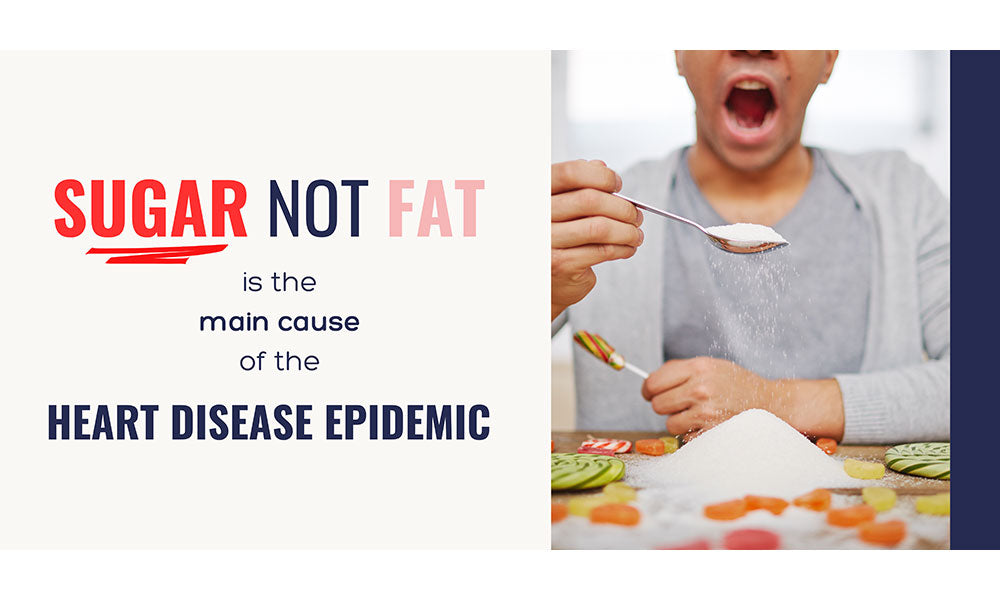
So sugar in food, and especially added sugar, is the real major health issue!
Reduction of sugar craving
Studies have consistently shown that diets low in protein trigger sugar cravings and obesity (Roberge JB et al., 2019) (Kim JE et al., 2016).
Whey protein intake can really help to control sugar cravings because proteins have an action on appetite and induce a satiety effect.

Consuming whey gives the sensation of feeling fuller longer. This biological effect has been described scientifically and is driven by hormones produced in the gut after whey intake. These hormones are called GIP (glucose-dependent insulinotropic polypeptide), GLP-1 (glucagon-like-peptide-1), CCK (cholecystokinin), PYY (Peptide YY) or ghrelin, and they send a signal of satiety to the brain (in the hypothalamus). So it’s gut-brain info which circulates via both blood and nerve (vagus nerve) routes (Lesgards et al., 2023). Other studies have demonstrated that whey proteins have a better effect on appetite control than other protein sources such as eggs, casein, or soy (Hall W et al., 2003) (Anderson G et al., 2004) (Uhe A et al., 1992) (Tahavorgar A et al., 2014).
Controlling hunger and sugar cravings is also essential to controlling or losing weight (avoiding the storage of triglycerides) and reducing sugar spikes in the blood (hyperglycemia), which are associated with oxidation/inflammation in the pancreas and the body. This is preventive for diabetes and CVDs.
Management of glycemia and blood lipids
The intake of quality whey proteins, in particular 60-90 minutes before a meal, increases insulin secretion in pancreatic β-cells which lowers glucose in the blood (glycemia) after a meal (postprandial state) (Frid AH et al., 2005) (Lesgards et al., 2023).
There are several mechanisms (see Figure 1 for more info and a global view): Some amino acids (AAs), particularly leucine, activate key enzymes like glutamate dehydrogenase for insulin production and inhibit the enzyme dipeptidyl peptidase-4 (DPP-4), which prevents the degradation of GIP and GLP-1, two peptides useful for insulin production (Lesgards et al., 2023).
Additionally, whey proteins slow down gastric emptying through various actions on the stomach and gut (relaxing the proximal stomach, reducing antral and duodenal motility, and increasing pyloric tone) thanks to GLP-1 which lowers glucose rise in the blood (Mignone LE et al., 2015) (Lesgards et al., 2023).
Also, the AA cysteine improves glucose metabolism in diabetic animals and type-2 diabetic patients, and Protelicious whey is particularly rich in sulfur-containing amino acids like cysteine and methionine (which can produce cysteine in the body) thanks to our cold filtration process, which preserves them from oxidation (Jain SK, 2012).
Furthermore, whey consumption has also been shown to decrease fasting triglycerides, total cholesterol and LDL cholesterol (“bad cholesterol”) in clinical studies (Lesgards et al., 2023).
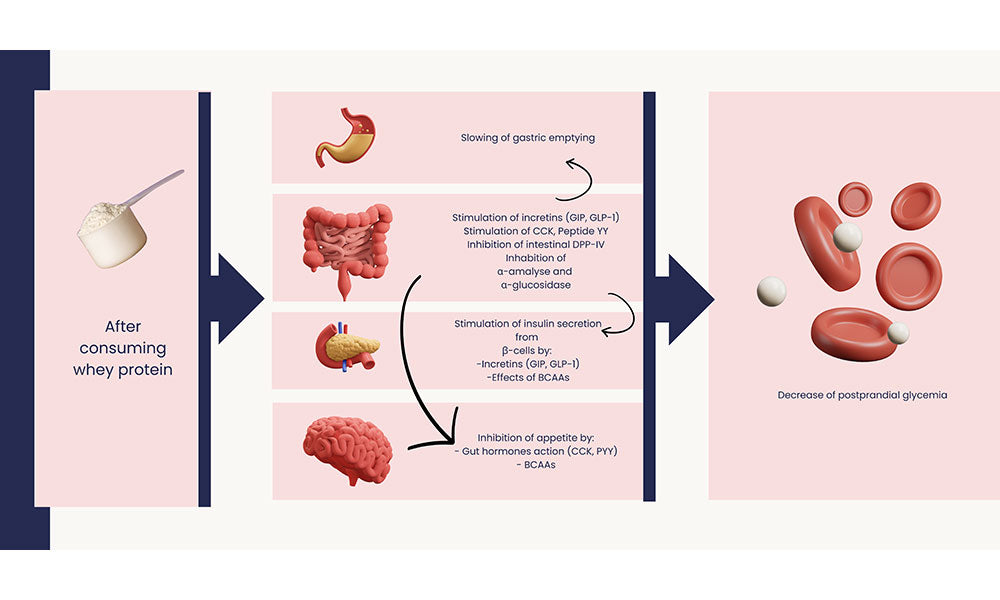
Figure 1. Mechanisms implicated in whey protein activity on postprandial glycemia reduction. GIP: glucose-dependent insulinotropic polypeptide; GLP-1: glucagon-like-peptide-1; CCK: cholecystokinin; PYY: peptide YY; DPP-IV: dipeptidyl peptidase-IV; BCAAs: branched-chain amino acids
Improvement of lean mass over fat mass
Consuming whey protein, particularly grass-fed cold-processed whey like Protelicious Whey Protein Concentrates (WPCs), which has probably the best amino acid (AAs) profile and digestibility among all foods, one can improve his lean mass (muscle) vs. fat mass ratio. Together with a bit of regular physical activity, it contributes to a healthier silhouette and control of body mass index (BMI) and weight.
Indeed, whey is particularly rich in branched-chain amino acids (BCAAs) like leucine, which triggers muscle synthesis (Devries MC et al., 2015) (Hulmi et al., 2010) (Fujita and Volpi, 2006). Furthermore, in clinical studies, whey protein has been found to stimulate muscle protein synthesis better than other proteins such as eggs, casein and soy (Devries MC et al., 2015).
Proteins are also essential for bones and joint health, making up a significant portion of both tissues. AAs intake plays a significant role in the continuous cycle of bone formation and resorption, maintaining bone health (Jennings A. et al., 2016) (Heaney RP and Layman DK, 2008).
The intake of 1-1.2 g/kg of body weight/day of quality proteins is particularly crucial for seniors to prevent protein breakdown from muscle and bones and loss of muscle mass associated with age (sarcopenia) (Rieu I et al., 2006).

ENHANCES ENERGY/IMPROVEMENT OF MENTAL FATIGUE AND PHYSICAL ENERGY
Help to fight mental fatigue and stress
Help to improve physical energy and recuperation
Help to fight mental fatigue and stress
Mental fatigue is a psycho-biological state caused by prolonged periods of demanding cognitive activity in an intense period of work, for example (affects concentration, mood and physical performance).

Whey is useful because it can contribute to increasing the synthesis of hormones like serotonin (the hormone of good mood and which regulates day cycles) thanks to its richness in tryptophan, melatonin (the hormone for sleep) and dopamine (the hormone for motivation, pleasure and reward) thanks to its richness in tyrosine (Markus CR et al., 2000) (Markus CR et al., 2002).
In addition, whey may also increase magnesium uptake by cells with the help of the AAs arginine and taurine (synthesized from other AAs such as cysteine or methionine, of which whey is richer than many protein sources), thus contributing to the reduction of stress which has a strong impact on mental fatigue.
Helps to improve physical energy and recuperation
Thanks to the unique richness of whey in its 9 essential amino acids (EAAs) and branched amino acids (BCAAs: leucine, isoleucine, and valine), it is useful to improve recovery and muscle damage as well as muscle fibre synthesis after exercise (Devries MC et al., 2015) (Davies RW et al., 2018).
Thanks to its contribution to the control of inflammationand oxidation, whey is useful for muscles/tendons through its richness in antioxidantAAs: cysteine, methionine, lysine, and taurine (made from cysteine) after long efforts and high-intensity physical activity (Sakelliou Aet al., 2016).

REINFORCES IMMUNITY
Protelicious whey protein concentrate is processed by ultrafiltration at low temperatures. This process protects all essential amino acids (EAAs), which are often partially damaged during the application of heat, either via standard industrial concentration treatment methods (heated, use of strong acids, ion exchange column extraction), whey (WPCs and whey protein isolates/WPIs) in other products on the market (for gyms and bodybuilding in particular), or excessive cooking in foods. The majority of these amino acids are very beneficial for your immune system.
Strengthens immune system and helps fight infections
A regular intake of whey protein strengthens the immune system by supporting our white blood cells, whether the innate immune system (neutrophils, macrophages, NK/natural killers), which constitute the body's first line of defence against viruses, bacteria and other pathogens but also adaptive or acquired immunity (T and B lymphocytes) which is more specific to a given pathogen and produces a memory for this infection (Ghezzi P 2011) (Morris D et al., 2013) (Muri J and Kopf M, 2021).
These cells require sulfur-containing AAs like cysteine and methionine for the synthesis of glutathione (GSH) in our body to function at their best and fight off viruses and bacteria (Madureira AR et al. 2007) (Dröge and Breitkreutz, 2000). The improvement of GSH levels also regulates the state of oxidation in all cells of our organism, which will also help to prevent against virus replications like influenza, coronaviruses and other respiratory viruses (Geiler J et al., 2010) (Gallo V et al., 2022) and potentially attenuate symptoms and improve survival (De Flora S et al., 1997) (Nencioni L et al., 2003).
Proteins and AAs are also necessary for the production of immunoglobulins (antibodies which are proteins) that recognize viruses and bacteria and bind to them to stop infection in our cells. Our high-quality whey protein concentrate is naturally rich in immunoglobulins (10-15 % of total proteins) that will be digested before reaching blood circulation and organs, which will thus receive the adequate ratio of AAs to produce and synthesize new immunoglobulins. Studies have shown that whey protein supplementation significantly increased immunoglobulin G levels (Bumrungpert A. et al., 2018).
Another mechanism by which whey proteins impact positively on immunity is gut health. Whey is very rich in glutamic acid, which can synthesize glutamine that brings energy to intestinal cells. Indeed, it is necessary for a healthy intestinal barrier to have tight junctions between cells to avoid pathogens or toxins from entering into the circulation: if the intestine becomes permeable, a condition called “leaky gut”, these molecules and bacteria go into the blood and can reach distant organs and cause inflammation, allergic reactions and auto-immune responses (Nagpal R et al., 2017).
Furthermore, AAs are also essential to maintain a balanced gut microbiota (a mix of “good" and “bad" or pathogenic bacteria, fungi and other microorganisms) and around 70% of all our immune cells are located in the gut (Dai ZL et al., 2011). The reason for this is that it is essential that the body deal with any pathogens in the gut so they don't enter the body. Also, more than 80% of the immunoglobulin-producing white blood cells (blasts and plasma cells) are located within the gastrointestinal tract, collectively called the gut-associated lymphoid tissue (GALT).
SLOWS AGING / REDUCES INFLAMMATION, IMPROVES ANTIOXIDANT AND DETOXIFICATION PROCESSES
Reduces inflammation, helps prevent chronic inflammatory conditions (diabetes, cardiovascular diseases, cancer) and supports and improves detoxification processes
Decades of international research show that chronic inflammation is devastating to the health of the entire body, causing chronic diseases like diabetes, heart disease, neurological diseases, cancer and aging. The lifestyle factors implicated in inflammation are prolonged imbalances in our food habits, lifestyle (smoke, stress) and environmental factors (pollution) that assault our cells through several biochemical reactions called oxidation. Oxidation of cells can be compared to metals rusting when exposed to oxygen. Prolonged oxidation (called “oxidative stress”) is associated together with chronic inflammation and can cause the onset of different pathologies that go from simple disorders like a decrease in skin quality, flu and colds, to more serious inflammatory diseases like cardiovascular disease, cancer, neurodegenerative diseases and others, as well as aging.
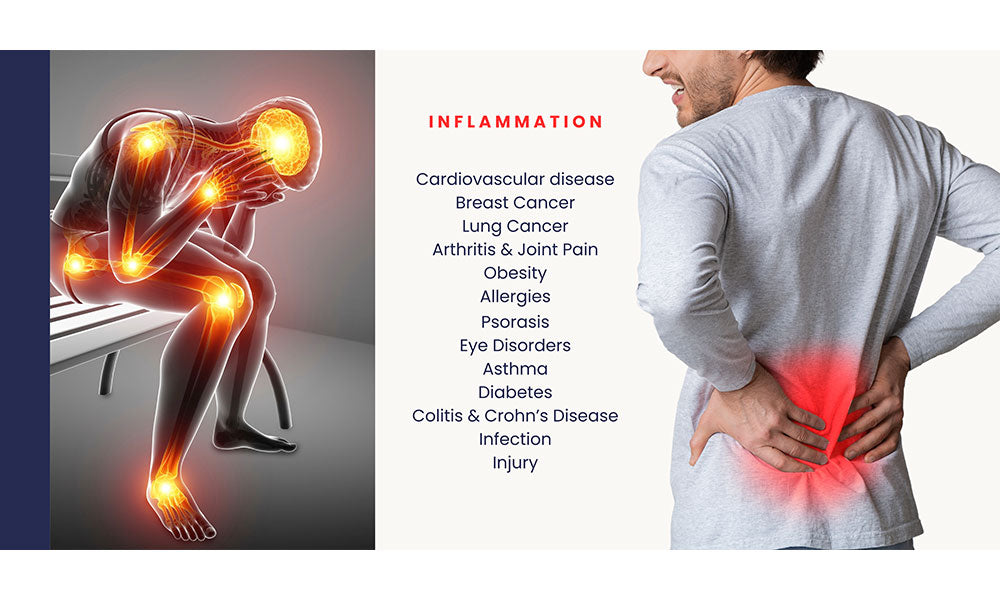
We all experience oxidation and inflammation in our bodies; it's unavoidable. However, we can control it, and one of the best ways to counteract it is by consuming antioxidant/anti-inflammatory compounds from diet and food supplements together with regular physical activity and stress management (Lesgards et al., 2002). Food is definitely a crucial aspect in this matter and adequate supplements such as whey and other quality antioxidants can be seen as efficient tools!
Reduces inflammation
With its exceptional richness in sulfur-containing AAs (cysteine, methionine), Protelicious grass-fed whey will boost the synthesis of glutathione (GSH), which is the master antioxidant/anti-inflammatory compound in the body and regulates the oxidative status in all cells. GSH also regenerates other essential antioxidants like vitamins E and C (brought from food) when they are oxidized (thanks to the dehydroascorbic acid/DHA reductase enzyme in the presence of GSH) and is regenerated itself by enzymes in our body (glutathione reductase) (Vašková, J et al., 2023).
Indeed, antioxidants like vitamins, polyphenols/flavonoids present in fruit and vegetables and many supplements on the market can be beneficial in fighting against oxidation and ageing, but they are consumed or "burned” when the body is under an oxidation state, and they are not regenerated (Lesgards et al., 2005).
The antioxidant and anti-inflammatory components of quality whey help neutralize these inflammatory processes (Lesgards et al., 2023). This also prevents and improves sarcopenia (muscle loss after age 65), which is also linked to chronic inflammation (Rieu I et al., 2006).
However, not all whey proteins are created equal. Many commercial whey proteins available use industrialized production processes, which involve heating products at high temperatures for a particular time, as well as strong acid and base treatment, which are known to denature proteins and possibly oxidize a part of the AAs, thereby diminishing their function and ability to fulfill their purpose. Protelicious, however, uses a cold ultrafiltration process, ensuring all AAs remain intact and bioavailable upon reaching the consumer.
Improves detoxification processes
Improving GSH content in cells is crucial for detoxifying the body from thousands of toxic and aggressive compounds such as aldehydes, pesticides, heavy metals, and endocrine disruptors.
GSH can be considered the best scavenger of the body and is very present in the liver, the great detoxifier organ. GSH has a natural affinity for binding these noxious molecules, and the enzyme glutathione transferase increases it up to 600 times, ultimately promoting the elimination of these compounds in urine.
IMPROVES GUT HEALTH
Supports gut health by maintaining a healthy gut barrier and by regulating gut microbiota
Gentle on the stomach and gut
The function of the gastrointestinal system is inseparably connected to the function of all the other organs in the body. Although we usually do not realize it, the gut is where you come into contact with the outside world to a more important extent than with skin and lungs. Indeed the gut has a much larger surface area that is exposed to the outside world: between 250 and 500 m2, which is much more than the skin (1.7 m2) and lungs (140 m2 surface exchange). It is more than a tennis field (260 m2), and intestine length is around 6 meters. Its job is hard as it must not only keep harmful pathogens and toxins out of the body but also allow for food to enter the bloodstream, hence its importance as a possible source of ill health.
When the gastrointestinal system is damaged or inflamed, the body will have to use even more energy and resources to maintain a healthy gut and immune system. Over time as the body's resources become depleted, the gastrointestinal immune system will begin to malfunction, and subsequently, the entire body's immune system will malfunction. The result is frequent illness, asthma, eczema, and allergies.
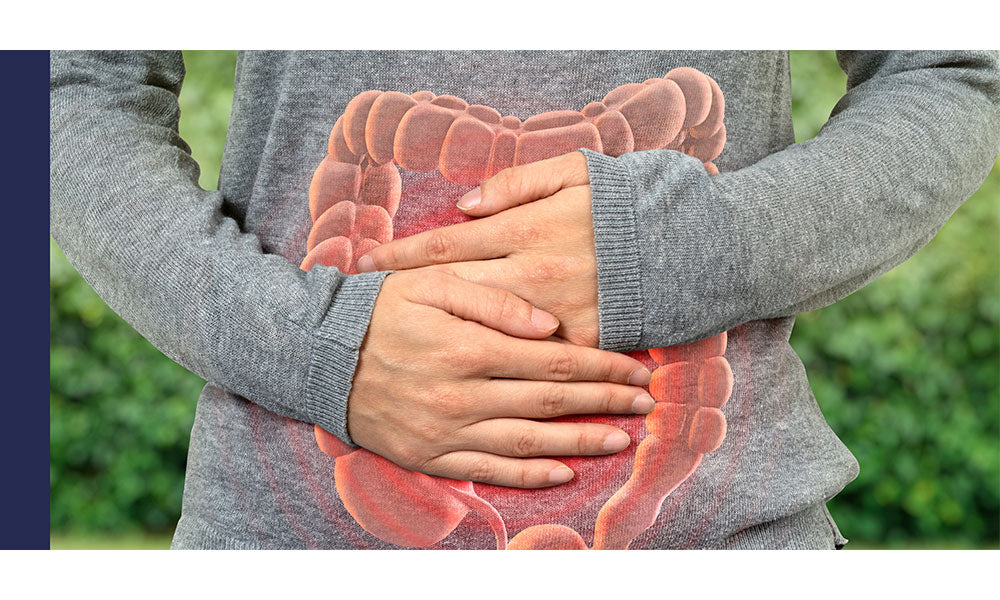
Supports gut health by maintaining a healthy gut barrier and by regulating gut microbiota
Findings from animal and human studies indicate an increasingly recognized and critical role for dietary AAs in maintaining gut health and preventing intestinal diseases (Reed PJ, 2000).
Protelicious whey fortifies the gut barrier (intestinal mucosa) thanks to glutamic acid, which is vital for glutamine synthesis. This fuels intestinal cells for energy, as glutamine, along with glutamate and aspartate, accounts for the majority of energy generated in the small intestine (Andrade ME et al., 2015) (Reed PJ, 2000).
The intestinal wall is carpeted with little fingers called villi which are very well vascularized where the passage of nutrients occurs from gut to blood circulation. These villi are themselves covered by smaller structures of the same form called microvilli which form a brush border and permit an extraordinary surface of exchange between intestine and blood circulation.
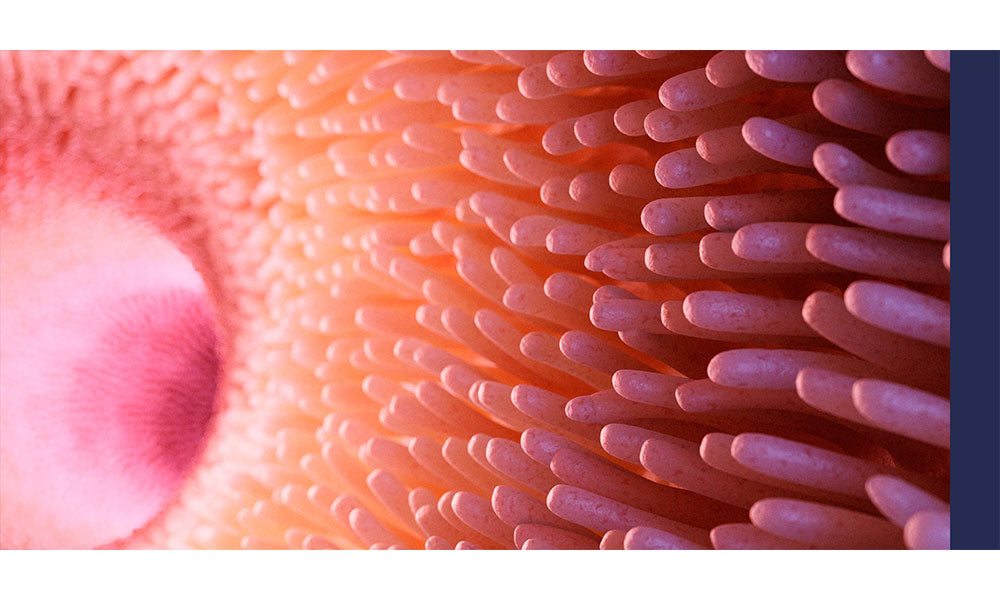
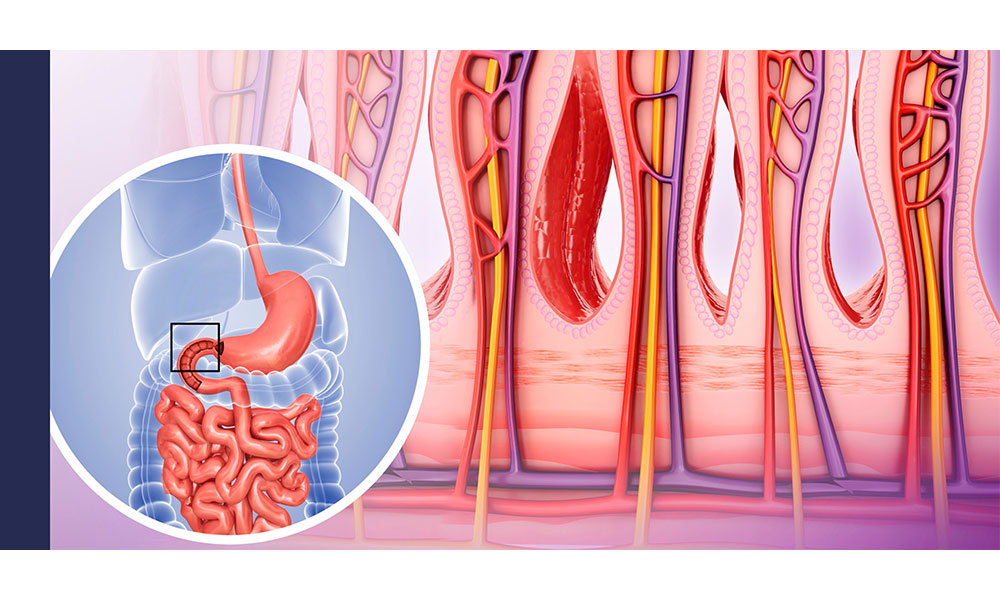
A healthy intestinal barrier where the junction between the cells are tight with one another (see “Microvilli (brush border) with electronic microscopy” above) is key for maintaining good digestion and gastrointestinal health, avoiding gut microbes, including potential pathogens and toxins from entering into the circulation. In a normal healthy gut membrane there is very limited transport through the tight junctions, forcing most substances to go through the cell in order to get into blood circulation. Leaky gut, or intestinal permeability, is a condition in which intestinal cells (bearing the microvilli) become damaged and lose their tightness, causing undigested food particles, toxins, allergens and bacteria to leak through the intestine and pass into the bloodstream (see above, cells on the right) (Lee SH, 2015) (Valenzano MC et al., 2015). These molecules and bacteria, once in the blood, can reach distant organs and cause inflammation, allergic reactions and auto-immune responses (Nagpal R et al., 2017). Also, glutamine together with cysteine for glutathione synthesis, counteract oxidation and inflammation of the gut barrier (Wang J et al., 2008) (Mondello S et al., 2010) and thus, the passage of toxins and bacteria in the bloodstream (Benjamin J et al., 2012).

Globally several studies support the potential therapeutic benefit of glutamine, glutamate, arginine, glycine, lysine, threonine, and the sulfur-containing AAs in gut-related disease (Wang W, 2009).
The major end products of methionine and cysteine metabolism are GSH, homocysteine and taurine, which play important roles in the intestinal immune response (Grimble 2006). (Bischoff SC et al., 2014). GSH in the gut lumen and gut cells (enterocytes) is of critical importance in maintaining normal intestinal function, in part, by protecting epithelial cells from damage by oxidants and fatty acid hydroperoxides (Aw et al. 1992).
Amino acids are also key to maintaining a balanced microbiota (a balanced mix of "good" and "bad" bacteria, fungi, and microorganisms) which is key for immunity and general health (Boscaini S et al., 2023).
The human body is host to a vast number of microbes, including bacterial, fungal and other microorganisms, which together constitute our microbiota or microbiome. The gut microbiota, which is by far the richest in the body, is sometimes called the forgotten organ and weighs between 1 and 2 kg. (O'Hara AM and Shanahan F, 2006). We have around 100 trillion (1014= 100 000 000 000 000) bacteria in our gut which is comparable to the number of cells in the whole body.
These bacteria flora are essential when it is well regulated. Among the important roles of these bacteria are:
- fermentation of non-digestible dietary residue
- participation in the synthesis of K vitamin (necessary for the coagulation process in blood) and the absorption of calcium, magnesium and iron
- protection against exogenous microorganisms
- prevent attachment and subsequent entrance in the blood of pathogen bacteria
- inhibit the growth of pathogenic bacteria through the synthesis of antimicrobial substances
The gut microbiota also contains other cells (archaea and fungi) and viruses (Minot S et al., 2011) (Hoffmann C et al., 2013).
BEAUTIFIES THE SKIN AND HAIR/IMPROVES SKIN AND HAIR QUALITY
Improves skin, hair and nails health: production of keratin and collagen
Provide hydration and soothing effect, acts in synergy with cosmetics
Enhances skin, nails and hair health: production of keratin and collagen
Consumption of whey protein provides essential AAs for the production of keratin and collagen which are key proteins in the skin, nails and hair structure for health, strength and appearance.

Keratin is the major protein (80%) produced by keratinocytes, the cells constituting 80-90% of the surface layer of skin epidermis, nails and hair. Cysteine is particularly abundant in keratin and whey is a very good supplier of sulfur AAs: cysteine and methionine.
Cysteine, along with methionine, is also one of the main constituents of hair, contributing to the formation of keratin for a quarter of the total (Labrozzi A. et al., 2020). Cysteine forms disulfide bridges (links between 2 cysteines through sulfur links: R-S-S-R), providing strength and rigidity to keratin. Consequently, the use of blends fortified with cysteine and methionine and cysteine and methionine-rich proteins promotes the repair of structural lesions and slows down hair loss (Goluch-Koniuszy ZS, 2016) (Trüeb RM, 2009). Lysine is also important, mainly present in the inner part of the hair root and contributes to hair shape and volume (Labrozzi A. et al., 2020).
Additionally, protein and whey protein intake, by stimulating the natural production of collagen and elastin in the dermis (under the epidermis), helps to make the skin plump and less sagging. The quality of the dermis is essential and useful for thermoregulation, healing and detoxification of the skin.
Also, the face has more than 50 muscles, and whey concentrate is the best protein food supplement for strengthening these muscles (Devries MC et al., 2015), contributing to their firmness.
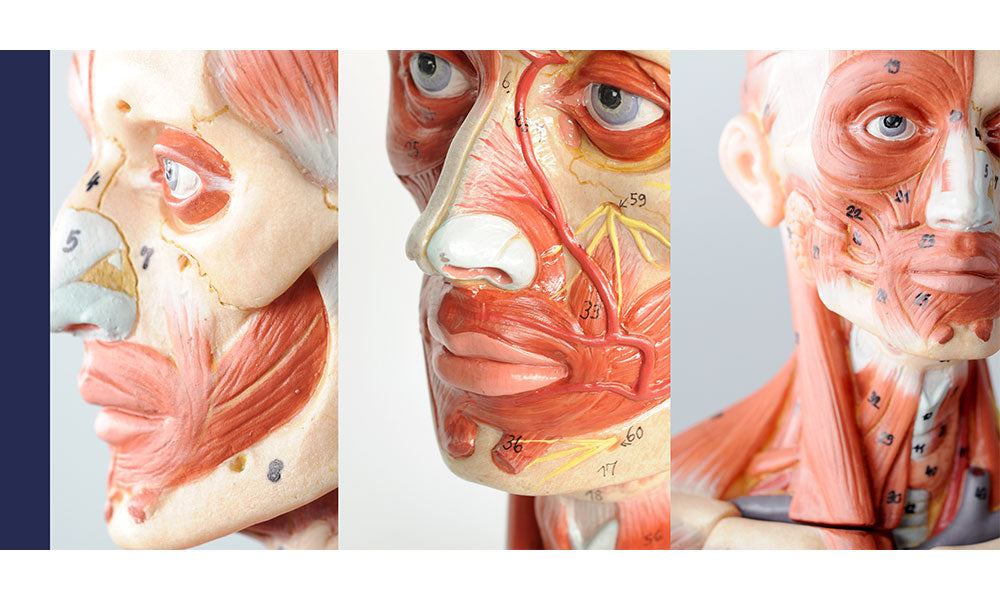
Hydration and soothing effect, synergy with cosmetics
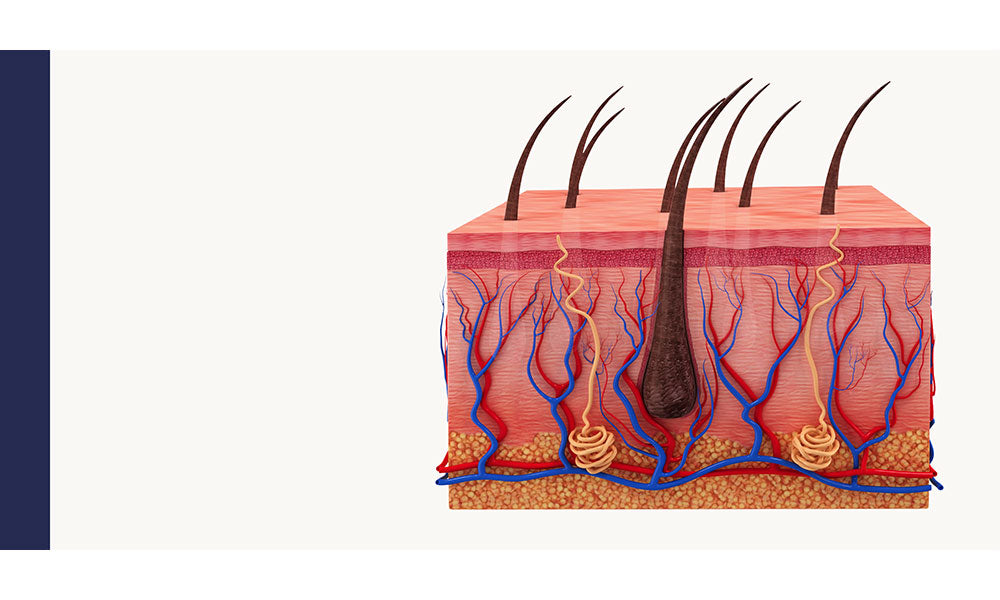
The Epidermis, the outermost layer of the skin, is where hydration of the skin occurs and keratinocytes retain water. Thus whey intake, which supports keratin synthesis, has an impact on hydration, and it has been shown on atopic skin in clinical studies (Holvoet S et al., 2021) (Bergandi L et al., 2022) (Alyasin S et al., 2012).
Quality whey intake can also improve the antioxidant/anti-inflammatory potential of skin through the synthesis of glutathione (GSH) thanks to its sulfur AAs content.
Thus, whey intake can act in synergy with topical cosmetics in particular for hydration and soothing of skin and is efficient on atopic skin (Holvoe, S et al., 2021) (Bergandi L et al., 2022) (Alyasin S et al., 2012). Besides, whey-derived products are used for making pharmaceuticals, cosmetics and skincare products (Mehra, R et al., 2021).
REFERENCES
Alyasin S, Nabavizadeh SH, Esmaeilzadeh H, Heydari ST, Mosavat SH, Parvizi MM, Hashemi SM, Hashempur MH. Efficacy of oral supplementation of whey protein in patients with contact dermatitis: A pilot randomized double-blind placebo-controlled clinical trial. Dermatol Ther. 2020 Nov;33(6):e14260. https://onlinelibrary.wiley.com/doi/10.1111/dth.14260
Anderson, G.H.; Tecimer, S.N.; Shah, D.; Zafar, T.A. Protein source, quantity, and time of consumption determine the effect of proteins on short-term food intake in young men. J. Nutr. 2004, 134, 3011–3015.
https://www.sciencedirect.com/science/article/pii/S002231662302881X?via%3Dihub
Andrade ME, Araujo RS, de Barros PA, Soares AD, Abrantes FA, Generoso Sde V, et al. The role of immunomodulators on intestinal barrier homeostasis in experimental models. Clin Nutr 2015;34: 1080–7. https://www.sciencedirect.com/science/article/pii/S0022316622083043?via%3Dihub
Aw TY, Williams MW, Gray L. Absorption and lymphatic transport of peroxidized lipids by rat small intestine in vivo: role of mucosal GSH. Am J Physiol. 1992 Jan;262(1 Pt 1):G99-106.
https://journals.physiology.org/doi/abs/10.1152/ajpgi.1992.262.1.G99
Benjamin J, Makharia G, Ahuja V, Anand Rajan KD, Kalaivani M, Gupta SD, Joshi YK. Glutamine and whey protein improve intestinal permeability and morphology in patients with Crohn's disease: a randomized controlled trial. Dig Dis Sci. 2012 Apr;57(4):1000-12. https://link.springer.com/article/10.1007/s10620-011-1947-9
Bergandi L, Flutto T, Valentini S, Thedy L, Pramotton R, Zenato S, Silvagno F. Whey Derivatives and Galactooligosaccharides Stimulate the Wound Healing and the Function of Human Keratinocytes through the NF-kB and FOXO-1 Signaling Pathways. Nutrients. 2022 Jul 14;14(14):2888.
https://www.mdpi.com/2072-6643/14/14/2888
Bischoff SC, Barbara G, Buurman W, Ockhuizen T, Schulzke JD, Serino M, et al.(2014). Intestinal permeability–a new target for disease prevention and therapy. BMC Gastroenterol. 14:189. https://bmcgastroenterol.biomedcentral.com/articles/10.1186/s12876-014-0189-7
Boscaini S, Skuse P, Nilaweera KN, Cryan JF, Cotter PD. The ‘Whey’ to good health: Whey protein and its beneficial effect on metabolism, gut microbiota and mental health. Trends in Food Science & Technology, Volume 133, 2023, Pages 1-14. https://www.researchgate.net/publication/367149024_The_'Whey'_to_good_health_Whey_protein_and_its_beneficial_effect_on_metabolism_gut_microbiota_and_mental_health
Bumrungpert A, Pavadhgul P, Nunthanawanich P, Sirikanchanarod A, Adulbhan A. Whey Protein Supplementation Improves Nutritional Status, Glutathione Levels, and Immune Function in Cancer Patients: A Randomized, Double-Blind Controlled Trial. J Med Food. 2018 Jun;21(6):612-616. https://www.liebertpub.com/doi/10.1089/jmf.2017.4080
Dai ZL, Wu G, Zhu WY. Amino acid metabolism in intestinal bacteria: links between gut ecology and host health. Front Biosci (Landmark Ed). 2011 Jan 1;16:1768-86. https://www.imrpress.com/journal/FBL/16/5/10.2741/3820
Davies RW, Carson BP, Jakeman PM. The Effect of Whey Protein Supplementation on the Temporal Recovery of Muscle Function Following Resistance Training: A Systematic Review and Meta-Analysis. Nutrients. 2018 Feb 16;10(2):221. https://www.mdpi.com/2072-6643/10/2/221
De Flora S., Grassi C., Carati L. Attenuation of influenza-like symptomatology and improvement of cell-mediated immunity with long-term N-acetylcysteine treatment. Eur. Respir. J. 1997;10:1535–1541. https://erj.ersjournals.com/content/10/7/1535
de Souza RJ, Mente A, Maroleanu A, Cozma AI, Ha V, Kishibe T, Uleryk E, Budylowski P, Schünemann H, Beyene J, Anand SS. Intake of saturated and trans unsaturated fatty acids and risk of all cause mortality, cardiovascular disease, and type 2 diabetes: systematic review and meta-analysis of observational studies. BMJ. 2015 Aug 11;351:h3978. https://www.bmj.com/content/351/bmj.h3978
Devries, M.C.; Phillips, S.M. Supplemental protein in support of muscle mass and health: advantage whey. J Food Sci 2015, 80 Suppl 1, A8-A15. https://doi.org/10.1111/1750-3841.12802
Dröge W, Breitkreutz R. Glutathione and immune function. Proc. Nutr. Soc. 2000;59:595–600. https://www.cambridge.org/core/journals/proceedings-of-the-nutrition-society/article/glutathione-and-immune-function/39488A395CB25E88283204A938A4CBD9
Frid, A.H.; Nilsson, M.; Holst, J.J.; Björck, I.M. Effect of whey on blood glucose and insulin responses to composite breakfast and lunch meals in type 2 diabetic subjects. Am. J. Clin. Nutr. 2005, 82, 69–75. https://www.sciencedirect.com/science/article/pii/S0002916523295118?via%3Dihub
Fujita S, Volpi E. Amino acids and muscle loss with aging. J Nutr 2006;136:277S–80S
https://www.sciencedirect.com/science/article/pii/S002231662208049X?via%3Dihub
Gallo V, Giansanti F, Arienzo A, Antonini G. Antiviral properties of whey proteins and their activity against SARS-CoV-2 infection. J Funct Foods. 2022 Feb;89:104932. https://www.sciencedirect.com/science/article/pii/S1756464622000020?via%3Dihub
Geiler J., Michaelis M., Naczk P., Leutz A., Langer K., Doerr H.W., Cinatl J., Jr. N-acetyl-l-cysteine (NAC) inhibits virus replication and expression of pro-inflammatory molecules in A549 cells infected with highly pathogenic H5N1 influenza A virus. Biochem. Pharmacol. 2010;79:413–420. https://www.sciencedirect.com/science/article/abs/pii/S000629520900728X?via%3Dihub
Ghezzi P. Role of glutathione in immunity and inflammation in the lung. Int J Gen Med. 2011 Jan 25;4:105-13. https://www.dovepress.com/role-of-glutathione-in-immunity-and-inflammation-in-the-lung-peer-reviewed-fulltext-article-IJGM
Goluch-Koniuszy ZS. Nutrition of women with hair loss problem during the period of menopause. Prz Menopauzalny. 2016 Mar;15(1):56-61. https://www.termedia.pl/Nutrition-of-women-with-hair-loss-problem-during-the-period-of-menopause,4,27186,0,1.html
Grimble RF (2006) The effects of sulfur amino acids intake on immune function in humans. J Nutr 136:1660S–1665S https://www.sciencedirect.com/science/article/pii/S0022316622083043?via%3Dihub
Hall, W.L.; Millward, D.J.; Long, S.J.; Morgan, L.M. Casein and whey exert different effects on plasma amino acid profiles, gastrointestinal hormone secretion and appetite. Br. J. Nutr. 2003, 89, 239–248. https://www.cambridge.org/core/journals/british-journal-of-nutrition/article/casein-and-whey-exert-different-effects-on-plasma-amino-acid-profiles-gastrointestinal-hormone-secretion-and-appetite/421C6E92A7A2D17069DA694F87CF0A2A
Heaney RP, Layman DK. Amount and type of protein influences bone health. Am J Clin Nutr. 2008 May;87(5):1567S-1570S. https://www.sciencedirect.com/science/article/pii/S0002916523236667?via%3Dihub
Hoffmann C, Dollive S, Grunberg S, Chen J, Li H, Wu GD, Lewis JD, Bushman FD. Archaea and fungi of the human gut microbiome: correlations with diet and bacterial residents. PLoS One. 2013 Jun 17;8(6):e66019. https://journals.plos.org/plosone/article?id=10.1371/journal.pone.0066019
Holvoet, S.; Nutten, S.; Dupuis, L.; Donnicola, D.; Bourdeau, T.; Hughes-Formella, B.; Simon, D.; Simon, H.-U.; Carvalho, R.S.; Spergel, J.M.; et al. Partially Hydrolysed Whey-Based Infant Formula Improves Skin Barrier Function. Nutrients 2021, 13, 3113. https://doi.org/10.3390/nu13093113
Hulmi JJ, Lockwood CM, Stout JR. Effect of protein/essential amino acids and resistance training on skeletal muscle hypertrophy: A case for whey protein. Nutr Metab (Lond). 2010 Jun 17;7:51. https://nutritionandmetabolism.biomedcentral.com/articles/10.1186/1743-7075-7-51
Jain, S.K. L-cysteine supplementation as an adjuvant therapy for type-2 diabetes. Can. J. Physiol. Pharmacol. 2012, 90, 1061–1064. https://cdnsciencepub.com/doi/10.1139/y2012-087
Jennings A, MacGregor A, Spector T, Cassidy A. Amino Acid Intakes Are Associated With Bone Mineral Density and Prevalence of Low Bone Mass in Women: Evidence From Discordant Monozygotic Twins. J Bone Miner Res. 2016 Feb;31(2):326-35. https://academic.oup.com/jbmr/article/31/2/326/7605577
Kearns CE, Schmidt LA, Glantz SA. Sugar Industry and Coronary card Disease Research: A Historical Analysis of Internal Industry Documents. JAMA Intern Med. 2016 Sep 12. https://jamanetwork.com/journals/jamainternalmedicine/fullarticle/2548255
Kim JE, O'Connor LE, Sands LP, Slebodnik MB, Campbell WW. Effects of dietary protein intake on body composition changes after weight loss in older adults: a systematic review and meta-analysis. Nutr Rev. 2016 Mar;74(3):210-24. https://academic.oup.com/nutritionreviews/article/74/3/210/1825906?login=false
Labrozzi A. (2020) Nutrients in Hair Supplements: Evaluation of their Function in Hair Loss Treatment. Hair Ther Transplant 10:150. https://www.longdom.org/open-access/nutrients-in-hair-supplements-evaluation-of-their-function-in-hair-loss-treatment-45472.html
Lee SH. Intestinal permeability regulation by tight junction: implication on inflammatory bowel diseases. Intestinal research. 2015; 13(1):11–8 https://irjournal.org/journal/view.php?doi=10.5217/ir.2015.13.1.11
Lesgards JF, Durand P, Lassarre M, Stocker P, Lesgards G, Lanteaume A, Prost M, Lehucher-Michel MP. Assessment of lifestyle effects on the overall antioxidant capacity of healthy subjects. Environ Health Perspect. 2002 May;110(5):479-86. https://ehp.niehs.nih.gov/doi/10.1289/ehp.02110479
Lesgards JF, Lehucher-Michel MP, Vidal N, Prost M, Stocker P. Assessment of antioxidative activity of lipid- and water-soluble vitamins in human whole blood. Comparative analysis between a biological test and chemical methods. Int J Vitam Nutr Res. 2005 Jan;75(1):11-8. https://econtent.hogrefe.com/doi/10.1024/0300-9831.75.1.11
Lesgards, J.F. Benefits of Whey Proteins on Type 2 Diabetes Mellitus Parameters and Prevention of Cardiovascular Diseases. Nutrients 2023, 15, 1294. https://doi.org/10.3390/nu15051294
Madureira, AR; Pereira, CI; Gomes, AMP; Pintado, ME; Xavier, Malcata F. Bovine whey proteins – Overview on their main biological properties. Food Res Int 2007, 40, 1197–211. https://doi.org/10.1016/j.foodres.2007.07.005
Markus CR, Olivier B, Panhuysen GE, Van Der Gugten J, Alles MS, Tuiten A, Westenberg HG, Fekkes D, Koppeschaar HF, de Haan EE. The bovine protein alpha-lactalbumin increases the plasma ratio of tryptophan to the other large neutral amino acids, and in vulnerable subjects raises brain serotonin activity, reduces cortisol concentration, and improves mood under stress. Am J Clin Nutr. 2000 Jun;71(6):1536-44. https://www.sciencedirect.com/science/article/pii/S0002916523071976?via%3Dihub
Markus CR, Olivier B, de Haan EH. Whey protein rich in alpha-lactalbumin increases the ratio of plasma tryptophan to the sum of the other large neutral amino acids and improves cognitive performance in stress-vulnerable subjects. Am J Clin Nutr. 2002 Jun;75(6):1051-6. https://www.sciencedirect.com/science/article/pii/S000291652306241X?via%3Dihub
Mehra, R.; Kumar, H.; Kumar, N.; Ranvir, S.; Jana, A.; Buttar, H.S.; Telessy, I.G.; Awuchi, C.G.; Okpala, C.O.R.; Korzeniowska, M.; et al. Whey Proteins Processing and Emergent Derivatives: An Insight Perspective from Constituents, Bioactivities, Functionalities to Therapeutic Applications. J. Funct. Foods 2021, 87, 104760. https://doi.org/10.1016/j.jff.2021.104760
Mignone, L.E.; Wu, T.; Horowitz, M.; Rayner, C.K. Whey protein: The “whey” forward for treatment of type 2 diabetes. World J. Diabetes 2015, 6, 1274–1284. https://www.researchgate.net/publication/283286568_Whey_protein_The_whey_forward_for_treatment_of_type_2_diabetes
Minot S, Sinha R, Chen J, Li H, Keilbaugh SA, Wu GD, Lewis JD, Bushman FD. The human gut virome: inter-individual variation and dynamic response to diet. Genome Res. 2011 Oct;21(10):1616-25. https://genome.cshlp.org/content/21/10/1616
Mondello S, Galuppo M, Mazzon E, Domenico I, Mondello P, Carmela A, et al. Glutamine treatment attenuates the development of ischaemia/reperfusion injury of the gut. Eur J Pharmacol 2010; 643:304–15. https://linkinghub.elsevier.com/retrieve/pii/S0014299910006357
Morris D, Khurasany M, Nguyen T, Kim J, Guilford F, Mehta R, Gray D, Saviola B, Venketaraman V. Glutathione and infection. Biochim Biophys Acta. 2013 May;1830(5):3329-49. https://www.sciencedirect.com/science/article/abs/pii/S0304416512002929?via%3Dihub
Muri J, Kopf M. Redox regulation of immunometabolism. Nat Rev Immunol. 2021 Jun;21(6):363-381. https://www.nature.com/articles/s41577-020-00478-8
Nagpal R, Yadav H. Bacterial Translocation from the Gut to the Distant Organs: An Overview. Ann Nutr Metab. 2017;71 Suppl 1:11-16. https://karger.com/anm/article-abstract/71/Suppl.%201/11/42330/Bacterial-Translocation-from-the-Gut-to-the?redirectedFrom=fulltext
Nencioni L, Iuvara A, Aquilano K, Ciriolo MR, Cozzolino F, Rotilio G, Garaci E, Palamara AT. Influenza A virus replication is dependent on an antioxidant pathway that involves GSH and Bcl-2. FASEB J. 2003;17:758–760.
https://faseb.onlinelibrary.wiley.com/doi/epdf/10.1096/fj.02-0508fje
O’Connor A, Sept. 12, 2016. How the Sugar Industry Shifted Blame to Fat. http://www.nytimes.com/2016/09/13/well/eat/how-the-sugar-industry-shifted-blame-to-fat.html?_r=0
O'Hara AM, Shanahan F. The gut flora as a forgotten organ. EMBO Rep. 2006 Jul;7(7):688-93. https://www.embopress.org/doi/full/10.1038/sj.embor.7400731
Reeds PJ, Burrin DG. The gut and amino acid homeostasis. Nutrition 2000;16:666–8.
Rieu I, Balage M, Sornet C, Giraudet C, Pujos E, Grizard J, Mosoni L and Dardevet D. Leucine supplementation improves muscle protein synthesis in elderly men independently of hyperaminoacidaemia. J Physiol 575.1 (2006) pp 305–315 305 https://physoc.onlinelibrary.wiley.com/doi/epdf/10.1113/jphysiol.2006.110742
Roberge JB, Van Hulst A, Barnett TA, Drapeau V, Benedetti A, Tremblay A, et al. Lifestyle habits, dietary factors, and the metabolically unhealthy obese phenotype in youth. J Pediatr. 2019;204:46–52.e1. https://www.jpeds.com/article/S0022-3476(18)31237-X/abstract
Sakelliou A, Fatouros IG, Athanailidis I, Tsoukas D, Chatzinikolaou A, Draganidis D, Jamurtas AZ, Liacos C, Papassotiriou I, Mandalidis D, Stamatelopoulos K, Dimopoulos MA, Mitrakou A. Evidence of a Redox-Dependent Regulation of Immune Responses to Exercise-Induced Inflammation. Oxid Med Cell Longev. 2016;2016:2840643. https://www.hindawi.com/journals/omcl/2016/2840643/
Tahavorgar A, Vafa M, Shidfar F, Gohari M, Heydari I. Whey protein preloads are more beneficial than soy protein preloads in regulating appetite, calorie intake, anthropometry, and body composition of overweight and obese men. Nutr Res. 2014 Oct;34(10):856-61. https://www.sciencedirect.com/science/article/abs/pii/S0271531714001663?via%3Dihub
Trüeb RM. Oxidative stress in ageing of hair. Int J Trichology. 2009 Jan;1(1):6-14. https://www.mdpi.com/1420-3049/23/3/575
Uhe, A.M.; Collier, G.R.; O’Dea, K. A comparison of the effects of beef, chicken and fish protein on satiety and amino acid profiles in lean male subjects. J. Nutr. 1992, 122, 467–472. https://www.sciencedirect.com/science/article/abs/pii/S002231662304590X?via%3Dihub
Valenzano MC, DiGuilio K, Mercado J, Teter M, To J, Ferraro B, et al. Remodeling of Tight Junctions and Enhancement of Barrier Integrity of the CACO-2 Intestinal Epithelial Cell Layer by Micronutrients. PloS one. 2015; 10(7):e0133926 https://journals.plos.org/plosone/article?id=10.1371/journal.pone.0133926
Vašková, J.; Kočan, L.; Vaško, L.; Perjési, P. Glutathione-Related Enzymes and Proteins: A Review. Molecules 2023, 28, 1447. https://doi.org/10.3390/molecules28031447
Wang J, Chen L, Li P, Li X, Zhou H, Wang F, et al. Gene expression is altered in piglet small intestine by weaning and dietary glutamine supplementation. J Nutr 2008;138:1025–32. https://www.sciencedirect.com/science/article/pii/S0022316622098145?via%3Dihub
Wang W, Qiao S, Li D. Amino acids and gut function. Amino Acids 2009;37:105–10 https://link.springer.com/article/10.1007/s00726-008-0152-4
Wu G, Meier SA, Knabe DA. Dietary glutamine supplementation prevents jejunal atrophy in weaned pigs. J Nutr 1996;126: 2578–84. https://www.sciencedirect.com/science/article/abs/pii/S0899900700003543?via%3Dihub
Globally several studies support the potential therapeutic benefit of glutamine, glutamate, arginine, glycine, lysine, threonine, and the sulfur-containing AAs in gut-related disease (Wang W, 2009).
The major end products of methionine and cysteine metabolism are GSH, homocysteine and taurine, which play important roles in the intestinal immune response (Grimble 2006). (Bischoff SC et al., 2014). GSH in the gut lumen and gut cells (enterocytes) is of critical importance in maintaining normal intestinal function, in part, by protecting epithelial cells from damage by oxidants and fatty acid hydroperoxides (Aw et al. 1992).
Amino acids are also key to maintaining a balanced microbiota (a balanced mix of "good" and "bad" bacteria, fungi, and microorganisms) which is key for immunity and general health (Boscaini S et al., 2023).
The human body is host to a vast number of microbes, including bacterial, fungal and other microorganisms, which together constitute our microbiota or microbiome. The gut microbiota, which is by far the richest in the body, is sometimes called the forgotten organ and weighs between 1 and 2 kg. (O'Hara AM and Shanahan F, 2006). We have around 100 trillion (1014= 100 000 000 000 000) bacteria in our gut which is comparable to the number of cells in the whole body.




